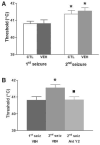Endogenous neuropeptide Y prevents recurrence of experimental febrile seizures by increasing seizure threshold
- PMID: 15800380
- PMCID: PMC2930787
- DOI: 10.1385/JMN:25:3:275
Endogenous neuropeptide Y prevents recurrence of experimental febrile seizures by increasing seizure threshold
Abstract
Febrile seizures (FSs) typically occur at the onset of fever and do not recur within the same febrile episode despite enduring or increased hyperthermia. Recurrent seizures during the same febrile episode are considered "complex," with potentially altered prognosis. A characterized immature rat model of FS was used to test the hypotheses that (1) a first FS influences the threshold temperature for subsequent ones, and (2) the underlying mechanisms involve the release and actions of the endogenous inhibitory hippocampal neuropeptide Y (NPY). Experimental FSs were induced two or three times, at 3- to 4-h intervals, and threshold temperatures measured. To determine the potential effects of seizure-induced endogenous NPY on thresholds for subsequent seizures, an antagonist of the major hippocampal NPY receptor (type 2) was infused prior to induction of the second seizure. As an indicator of NPY release, NPY expression was determined 4 and 24 h later. Threshold core and brain temperatures for hyperthermic seizures were consistent with those observed during human fever. Threshold temperatures for a second and third seizure were significantly and progressively higher than those required for the first. This "protective" effect involved induction of endogenous NPY because it was abolished by the NPY antagonist. In addition, NPY mRNA expression was increased in dentate gyrus, CA3 and CA1, after an experimental FS, consistent with peptide release. Collectively these data indicate that the absence of repetitive seizures during a febrile episode involves the inhibitory actions of endogenous NPY, suggesting that the signaling cascade triggered by this peptide might provide targets for therapeutic intervention.
Figures




References
-
- Aldenhoff JB, Gruol DL, Rivier J, Vale W, Siggins GR. Corticotropin releasing factor decreases postburst hyperpolarizations and excites hippocampal neurons. Science. 1983;221:875–877. - PubMed
-
- American Academy of Pediatrics: Committee on Quality Improvement, Subcommittee on Febrile Seizures. Practice parameter: long-term treatment of the child with simple febrile seizures. Pediatrics. 1999;103:1307–1309. - PubMed
-
- Annegers JF, Hauser WA, Shirts SB, Kurland LT. Factors prognostic of unprovoked seizures after febrile convulsions. N Engl J Med. 1987;316:493–498. - PubMed
-
- Baram TZ. Animal models for febrile seizures. In: Baram TZ, Shinnar S, editors. Febrile Seizures. Academic Press; San Diego, CA: 2002. pp. 189–203.
Publication types
MeSH terms
Substances
Grants and funding
LinkOut - more resources
Full Text Sources
Research Materials
Miscellaneous

